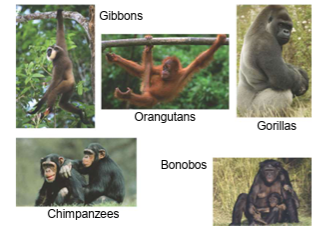Theme 14-The Origin and Evolution of Vertebrates
1/71
Earn XP
Description and Tags
Bio
Name | Mastery | Learn | Test | Matching | Spaced |
|---|
No study sessions yet.
72 Terms
What are the two developmental paths of the blastula in most Bilateria?
Protostomes (blastopore becomes mouth) and Deuterostomes (blastopore becomes anus).

What are Hemichordates and their key traits?
Phylum Hemichordata (~85 species) — marine animals (like acorn worms) that live in mud or under rocks; share traits with chordates such as gill slits and a dorsal nerve cord; can grow over 2 meters long.
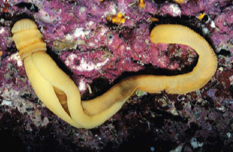
What animals are in Phylum Echinodermata?
Echinoderms (~7,000 species) include sea stars, sea urchins, sea cucumbers, sea daisies, and sand dollars.
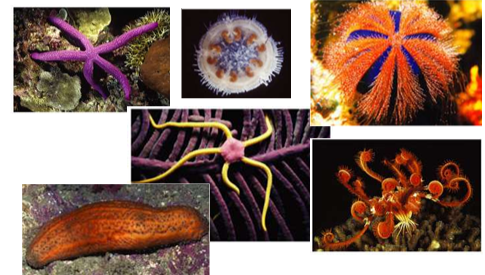
What type of symmetry do echinoderms have?
Adults have radial symmetry, while larvae are bilaterally symmetrical.
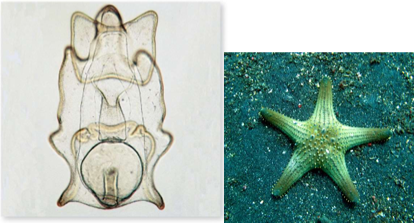
How are echinoderm body systems organized?
All systems radiate from a central axis, and they have an endoskeleton covered by epidermis.

Describe echinoderm nervous and reproductive systems.
They have a nerve ring with branches (no brain). Most reproduce sexually, are gonochoric, and release gametes into water—many can also regenerate lost parts.
What does Gonochoric mean?
Gonochoric means that each individual is either male or female, not both.
Echinodermata Diversity
Echinoidea – sea urchins, sand dollars
Ophiuroidea – brittle stars
Holothuroidea – sea cucumbers
Crinoidea – sea lilies, feather stars
Asteroidea – sea stars
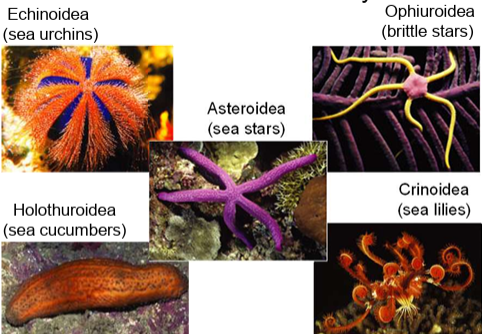
Anatomy of a Sea Star (Asteroidea)

Water-Vascular System (Echinoderms)
A hydraulic system used for movement, feeding, respiration, and waste transport.
Water enters through the madreporite → moves through canals → fills tube feet.
Tube feet extend and contract by water pressure, allowing the animal to move and grasp surfaces or prey.
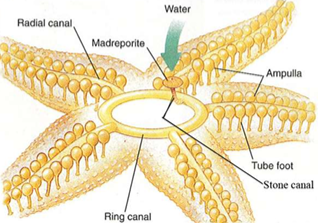
What is the function of the water-vascular system in echinoderms?
Hydraulic system used for locomotion, feeding, respiration, and waste transport.
How do echinoderms move using the water-vascular system?
Muscles force water into tube feet, causing them to extend and push against surfaces; relaxing muscles retracts the feet.
What is the path of water flow in the system?
Madreporite → stone canal → ring canal → radial canals → tube feet.
Phylum Chordata
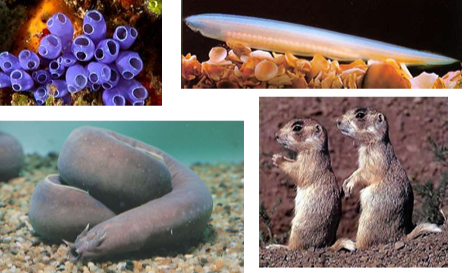
All chordates look like this as embryos
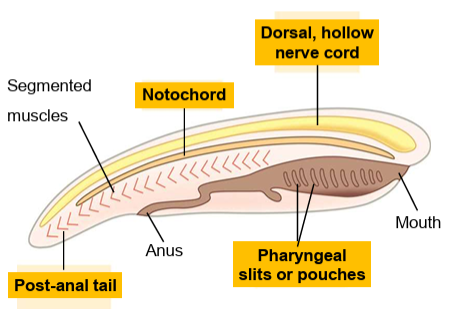
What are the key derived characters (synapomorphies) of chordates?
Notochord
Hollow dorsal nerve cord
Pharyngeal slits or clefts
Muscular post-anal tail
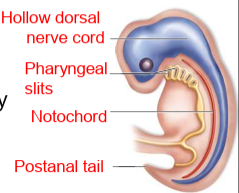
What is the function of the notochord?
Provides skeletal support during early development.
What is the function of the hollow dorsal nerve cord?
Develops into the central nervous system (brain and spinal cord).
What is the function of pharyngeal slits or clefts?
In aquatic species, allow water to pass from the mouth to outside the body, bypassing the digestive tract.
What is the function of the muscular post-anal tail?
Provides propelling force in aquatic species.
How are chordate muscles organized?
Muscles are arranged in segmented blocks called somites.
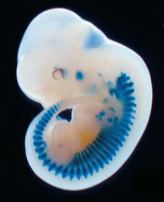
What type of skeleton do most chordates have?
Most have an internal skeleton (endoskeleton) that muscles work against.
What are the three subphyla of chordates?
Urochordates – invertebrates
Cephalochordates – invertebrates
Vertebrates – animals with a backbone
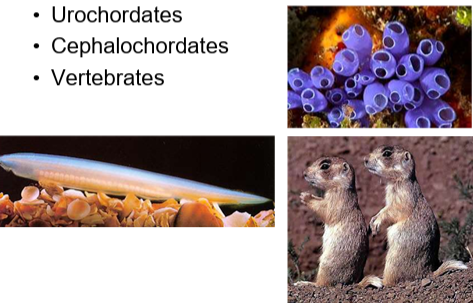
What is a key feature of Cephalochordates?
They have a ‘primitive’ brain but no skull.
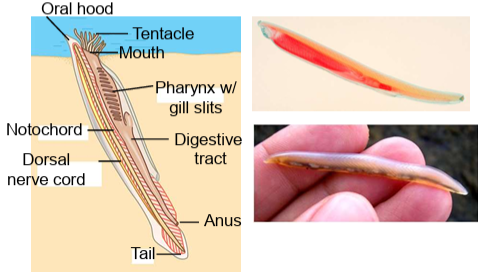
Does Cephalochordata have a brain?
Yes, they have a primitive brain, but no skull.
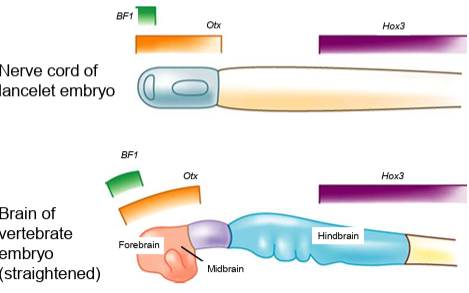
What is Haikouella and its key features?
Fossil chordates that resembled lancelets, were suspension feeders, had a well-formed brain, but lacked a skull.
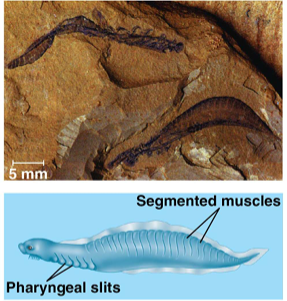
What happens to the notochord and tail in adult Urochordates (tunicates)?
Adults lose the notochord and tail.
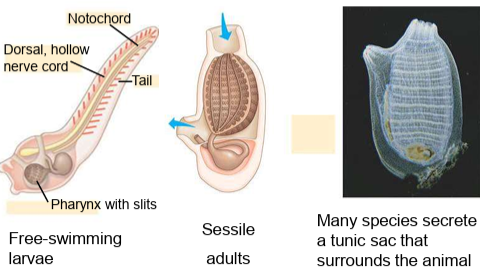
What is a key feature of Myxini (hagfish)?
They have a skull that contains the brain.

What is Myllokunmingia and its significance?
Fossil chordates that were the first to have a head (brain, eyes, sensory organs) but lacked vertebrae.
Significance: The head enabled more complex movement and feeding behaviors.
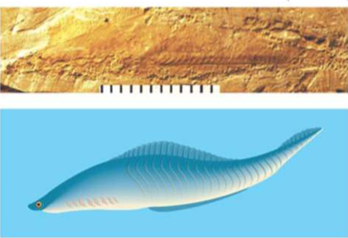
Examples of vertebrates
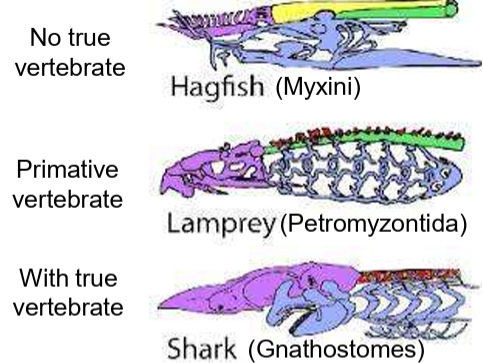
What happens to the notochord in adult lampreys?
It persists as the main axial skeleton.
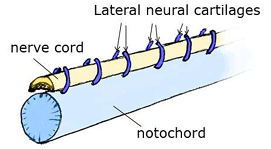
What surrounds the notochord in lampreys?
A cartilaginous pipe surrounds it.
What are the dorsal cartilaginous projections in lampreys?
They partially enclose the nerve cord and are a vestige of an early vertebral column.
What are conodonts and their key features?
Early vertebrate fossils that:
Used a muscular pharynx to suck in prey
Had barbed hooks in the mouth to secure prey
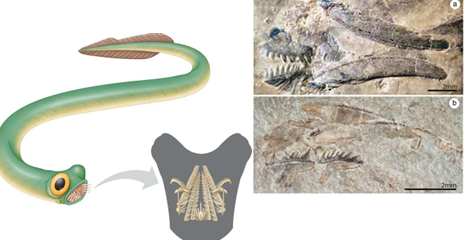
How do modern fish capture and secure prey?
Use a muscular pharynx to suck in prey
Teeth on the jaws secure the prey (instead of barbed hooks like conodonts)
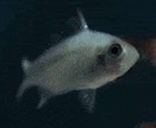
Some other early vertebrate animals
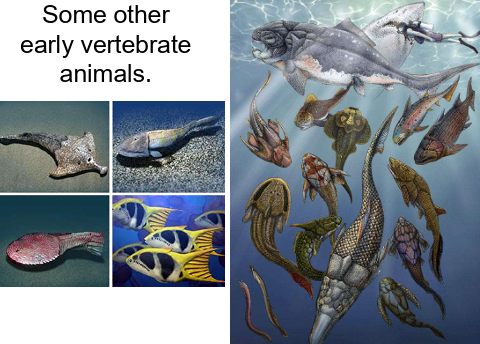
What key features appear in Gnathostomes (sharks and beyond)?
Jaws and paired appendages.

Gnathostomes animals with jaws
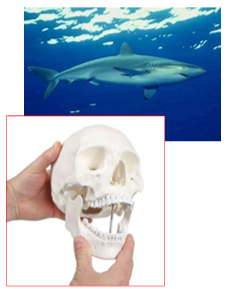
Agnathans animals without jaws
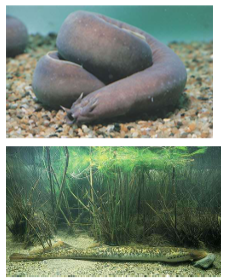
What is the significance of jaws in gnathostomes?
Jaws, with muscles and teeth, allow the animal to grip and process food firmly.
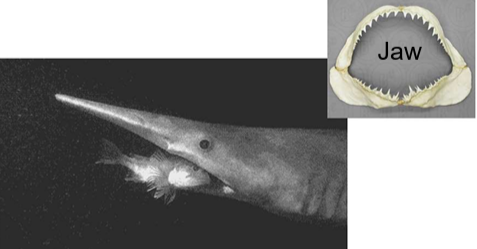
What are other key features of gnathostomes besides jaws?
Enlarged forebrain
Enhanced sensory systems, including the lateral line system (detects vibrations along body sides)
Extensively mineralized endoskeleton
Paired appendages
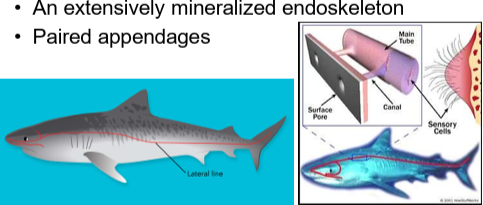
What features do gnathostomes have related to skeleton and appendages?
They have a mineralized endoskeleton, two pairs of appendages, and a tail.

Some early jawed vertebrates
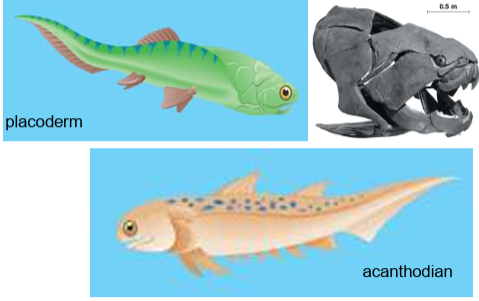
What is a key feature of Class Chondrichthyes (sharks, rays, ratfishes)?
They have flexible endoskeletons made of cartilage, not bone.
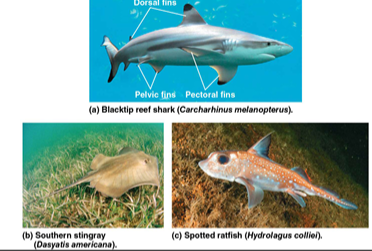
What defines Osteichthyes (bony fish and beyond)?
Bony endoskeleton
Includes bony fishes and tetrapods
Most vertebrates are osteichthyans
Aquatic osteichthyans are the vertebrates we commonly call fishes
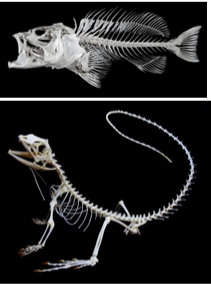
What are the three extant classes of Osteichthyes?
Actinopterygii – ray-finned fishes
Actinistia – lobe-finned fishes (coelacanths)
Dipnoi – lungfishes
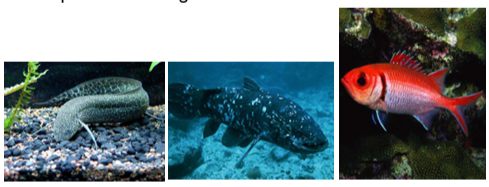
Actinopterygii (ray-finned fishes)
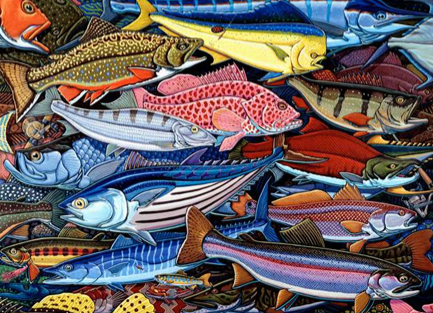
What are key features of Actinopterygii (ray-finned fishes)?
Gills protected by operculum
Water flows from mouth over gills
Swim bladder helps maintain buoyancy
Body and fin modifications affect maneuvering, defense, and other functions

What are the key lineages of Sarcopterygii (lobe-finned fishes & beyond)?
Coelacanths (Actinistia)
Lungfishes (Dipnoi)
Tetrapods (amphibians and beyond)

What is notable about Actinistia (coelacanths)?
Most were likely freshwater with lungs, though some later adapted to marine environments.
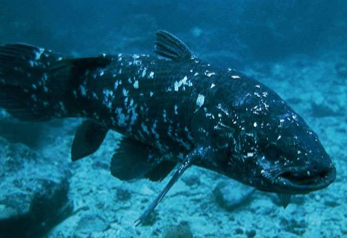
What are key features of Dipnoi (lungfishes)?
Live in stagnant ponds and swamps
Gas exchange via gills in water or lungs by gulping air attached to the pharynx
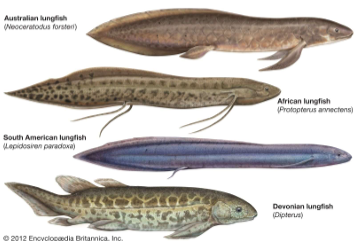
Tetrapods (Amphibians & beyond), Here come legs (& digits)!

Transitional fossils (e.g., Tiktaalik) have been found in recent decades
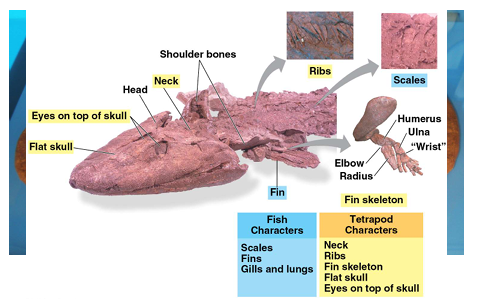
The Origins of Tetrapods

What are key adaptations of tetrapods for life on land?
Four limbs with digits
Neck for independent head movement
Pelvic girdle fused to backbone
Loss of gills (except some aquatic species)
Ears for detecting airborne sounds
What are the three extant orders of amphibians?
Urodela – salamanders
Anura – frogs
Apoda – caecilians
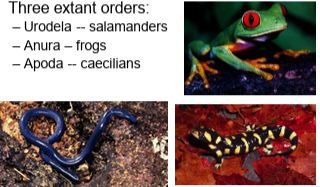
Amniotes (Reptiles & beyond) Here come amniotic eggs !
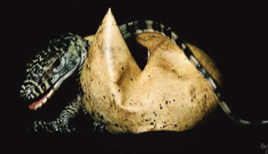
Why are amniotes successful on land?
They have amniotic eggs with four membranes: amnion, chorion, yolk sac, allantois
These membranes protect the embryo and reduce dependence on water for reproduction
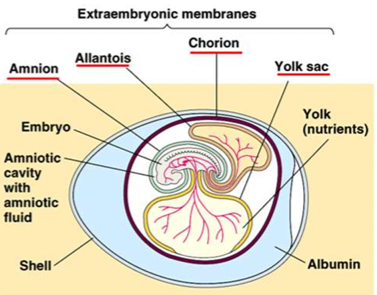
What additional adaptations helped amniotes succeed on land?
Waterproof skin
Enhanced lung ventilation using the rib cage
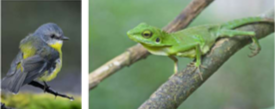
Phylogeny of Amniotes
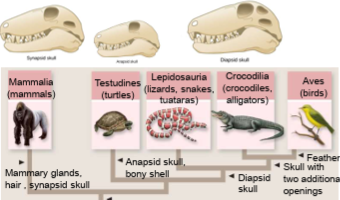
The Reptile Clade
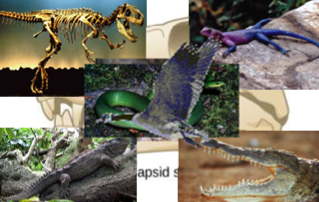
What are key characteristics of the reptile clade?
Keratinized scales protect against desiccation and abrasion
Shelled eggs laid on land; fertilization is internal before shell formation
Most reptiles are ectothermic (use external heat)
Birds (within reptiles) are endothermic (maintain body temp metabolically)
Birds are reptiles !! Birds are dinosaurs !!
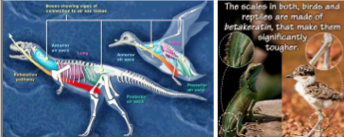
Mammalia Here comes milks and hair!
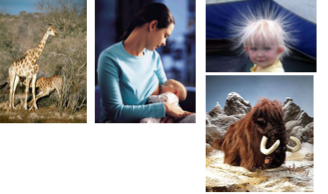
Mammalia subclasses
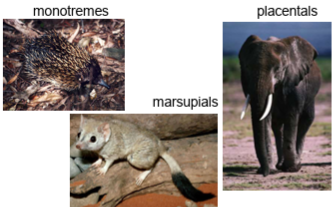
What are the three subclasses of mammals?
Monotremes – egg-laying mammals with shelled eggs
Marsupials – pouched mammals; embryos finish development in external pouch
Eutherians – placental mammals; placenta nourishes embryo throughout development
Monotremes Platypus and echidnas
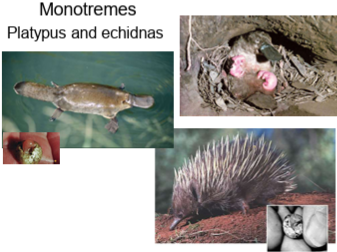
Marsupials Here comes pouches!
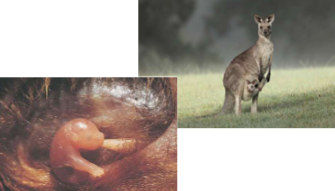
How do eutherians develop their embryos?
Embryos develop inside the uterus and are connected to the mother by a placenta, which nourishes them throughout development.

Order Primates Here comes you and me!
• Lemurs • Tarsiers • Monkeys • Apes
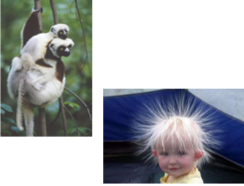
What are the derived characters of primates?
Large brain and short jaws
Forward-facing eyes close together → depth perception
Well-developed parental care and complex social behavior
Fully opposable thumb

Hominoids (Apes)
